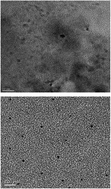Extremely high color rendering white light from surface passivated carbon dots and Zn-doped AgInS2 nanocrystals†
Abstract
In this study, highly luminescent carbon dots with diameters of 3–5 nm were synthesized via the carbonization of citric acid, and the effects of surface passivation and carbonization temperature on the optical properties were investigated. A red-shift in the emission wavelength was observed with increasing excitation wavelength, and oleylamine-capped carbon dots showed the highest quantum yield of approximately 43% when excited at 380 nm, whereas the reaction temperature had no influence on the emission wavelength and morphology of the dots. Additionally, I–III–VI AgInS2 nanocrystals (NCs) were prepared by thermal decomposition at a low temperature, and the emission wavelength was tuned by adjusting the growth temperature or introducing Zn ions, which enhanced the quantum yield up to 50%. For carbon dot application, a white LED was fabricated by combining a 380 nm UV LED with the carbon dots and Zn-doped AgInS2 NCs. White light from this LED exhibited an excellent color rendering index of greater than 95 with a warm color temperature, and demonstrated its potential for use in solid state lighting.


 Please wait while we load your content...
Please wait while we load your content...